Updated – Originally published July 20, 2022
Grooming is a terrifying subject for any parent to face, but understanding it can empower you to create a safe haven for your kids. The more you know about the signs of grooming, the better equipped you will be to protect your children and, if necessary, help them heal.
Definition: What Is Grooming?
Grooming is the process sexual predators use to identify, coerce, and silence their victims (especially children) in-person or online.
Children aren’t the only ones who are susceptible. Predators might also groom parents and other family members to get closer to victims, cast doubts on claims against them, and ultimately minimize their risk of being caught.
Groomers imitate normal interactions between kids and adults, making it hard to detect. However, you can spot potential red flags and protect your children from predators by learning about their tactics.
The Pattern of Grooming & 5 Tactics Predators Take
Sexual predators typically follow a common model in grooming their victims:
- Select a victim
- Gain access to & isolate them
- Develop trust
- Desensitize the child
- Maintain control
Not every predator will go through these stages or follow them in this order. Groomers will switch between stages and skip some parts based on the child’s response. For instance, a predator might step back and refocus on gaining trust if a child feels uncomfortable or nervous about their physical advances.
Despite its fluidity, this model can help you identify red flags. Parents might, for example, question the motive of an acquaintance who repeatedly offers to drive a child home, tutor them at their house, or make other requests to spend alone time with the child.

Remember, not every offer to work with a child or help your family is nefarious. Most people simply want to make a positive impact.
The purpose of learning about these grooming behaviors isn’t to question every interaction between your child and the adults in their life, but to be on the lookout for clusters, high frequency, or severe examples of suspicious behaviors.
Let’s look at each tactic in more detail.
1. Select a Victim
Offenders often begin by observing and collecting personal information about potential victims. They may target children based on physical characteristics (youth or body type), psychological traits (trusting or low self-esteem), and family situations (discord or single-parent home) that can increase vulnerability.
2. Gain Access to and Isolate the Victim
Abusers will take steps to isolate the child from others. They might sign up to coach, volunteer to tutor, or offer to babysit. If the activities are not already private, an abuser will often try to create situations to be alone with the child. This might include private practice sessions, special day trips, or requests for the child’s help at the predator’s house.
3. Develop Trust
Predators will often try to gain a victim’s trust. They want to convince the child that they are likable, loving, caring, and reliable. Some of their techniques include:
- Offering gifts, money, toys, and treats
- Taking the child on trips
- Giving compliments
- Offering support, love, stability, and protection
- Listening to and validating feelings
- Showing interest in hobbies, goals, likes, and dislikes
- Serving in the community
- Showing favoritism toward the child
- Providing drugs, alcohol, or adult entertainment
- Sharing secrets and making the child feel important
4. Desensitize the Child
Offenders will try to desensitize their victims by making their sexual advances seem normal or natural. They might discuss explicit sexual content, tell dirty jokes, show them pornography, or ask about the victim’s sex life. They may also touch victims in apparently harmless ways — tickling, hugging, or wrestling — before escalating to more sexual contact like massages, showering, or asking for nude pictures.
Often, gaining trust and desensitizing the child will go hand in hand. For instance, a predator may compliment the child on their body or offer to be a guide in exploring sexuality. Consequently, minors can develop a deep emotional connection with their abusers so that they don’t consider themselves victims.
Even after child sexual abuse has occurred, survivors might report that they are in love or in a relationship with their abusers rather than victims of sexual predation.
5. Maintain Control
Groomers often take steps to maintain control of their victims after sexually abusing them. They might do this to ensure future exploitation and prevent the child from telling anyone. Beyond the tactics mentioned above, predators might also bribe, threaten, or blackmail victims to keep them silent and subservient.
Changes in Behavior May Signal Abuse
When it comes to online sexual abuse, it can be hard to separate the signs from normal adolescent behavior like teenage angst. Experts encourage parents to watch for changes in behavior and to regularly talk with their kids about their digital lives.
Children who experience sexual abuse often feel shame, guilt, and confusion, and tend to isolate themselves from others. Signs that a child has been abused may manifest in the following ways:
Changes in Internet Behavior
Suddenly spending more time online or showing anxiety when they can’t access the internet can be signs that something’s wrong.
If a child hides what they’re doing online — like switching screens, placing their device face down, or avoiding questions — it could indicate a problem. Predators often encourage secrecy and use tricks, like acronyms or codes, to hide their intentions.
Changes in Sexual Behavior
It’s natural for kids to be curious about their bodies, and many engage in what experts call “early childhood exploration.”
However, when a child shows knowledge about sex that is too advanced for their age, or engages in sexual talk or conduct with peers, this may signal that the child has been abused.
Changes in Social Behavior
Withdrawal from social relationships is a common warning sign. Victims often pull away from friends and activities they once enjoyed or show a decrease in school attendance or performance.
Perpetrators often seek to maintain control by sending their victims money or gifts. Unexplained possessions or cash could indicate an unhealthy relationship with someone who is manipulating them.
Grooming the Family & Community
Predators will often use a similar grooming process with the victim’s family or community. They might spend time with the family, show interest in their lives, and offer help to gain trust. Similarly, they might work to improve their reputation in the community or build trust and confidence.
By grooming parents and community members, predators increase their access to children, foster trust with kids, and make it harder for others to believe accusations made by their victims.
Online Grooming
Online groomers follow a similar process to in-person predators, only faster. They often introduce sexualized content within the first 24 hours of chatting, and sometimes in as little as 30 minutes.
For the most part, online predators adapt the five stages (identify, access and isolate, gain trust, desensitize, and maintain control) to fit digital interactions. For example, instead of coaching a youth soccer team, predators might use online gaming platforms that are popular with children like Roblox or Minecraft to identify potential victims.

If the platform doesn’t allow for private chat, predators will often try to move their conversation to social media — like TikTok, Instagram, WhatsApp, or Snapchat — where they can interact more freely.
To build trust, online predators might (but not always) pose as a child the same age as the victim or a slightly older peer of the opposite sex. They might even create multiple fake accounts, then introduce their victim to these fake friends to build a false sense of security.
Signs of Grooming
Grooming can be hard to spot because it tries to like normal adult-child interactions in most ways. With that being said, there are red flags that can alert you that something is amiss with your child.
Parents can avoid unnecessary fear by focusing on clusters of behaviors, high frequency patterns, or examples of suspicious behaviors.
Signs of Grooming by a Parent or Family Member
Teachers, coaches, community leaders, and other adults can help parents recognize signs of grooming. Sadly, parents sexually abusing their children are all too common, accounting for 35% of all instances of abuse. For this reason, it’s critical to stay alert to warning signs that a child — and not just for your own — is being abused by a parent or family member.
“Parents would benefit from learning more about grooming tactics so that suspicion may be raised if clusters, high-frequency use, or the most severe of these potentially worrisome behaviors are present in a person spending time with children.”
—Dr. Georgia M. Winters, Assistant Professor, School of Psychology and Counseling, Fairleigh Dickinson University
What are Signs of Online Grooming?
Aside from those mentioned above, there are other signs of online grooming to watch for. Without hesitation, parents should feel empowered to ask questions and expect transparency from any adult who spends time with their children.
Adults who truly have your child’s best interests at heart will be open and forthcoming about their intentions.
Effects of Grooming
Grooming impacts children differently depending on several factors, such as the predator’s methods, the victim’s relationship with the groomer (as well as other adults), how long the grooming lasted, how it ended, the severity of the abuse, and the child’s resilience.
Sadly, children targeted by unwanted sexual solicitation are:
- 3x more likely to experience depression symptoms or post-traumatic stress disorder
- 2.6 x more likely to abuse drugs and alcohol
- nearly 2x as likely to commit delinquent crimes.
When abused, the effects are worse:
- 10.5x as likely to experience depression
- 8.5x higher rates of substance abuse
- 5x more likely to engage in criminal behavior.
Young people who have been victims of sexual abuse are also more likely to struggle in school, display violent behavior, and die by suicide.
What to Do if a Child Reveals They’ve Been Groomed or Abused
If a child has been groomed, there is still hope. Identifying and stopping the grooming early can greatly reduce long-term effects. Even in cases where grooming or sexual abuse has gone on for years, parents can still make a difference by providing support and getting their kid professional help.

If a child tells you they’ve been abused, they trust you. Thank them for that trust, offer help, and listen without judgment.
RAINN is an excellent resource for any adult working with children. They offer guidance on talking to kidsgrooming or abuse, tips for bystanders to prevent child sexual abuse, and more.
For more information on how to support a survivor, visit the RAINN website.
How to Report Grooming
If you suspect that a child is being groomed or has been sexually assaulted, it’s crucial you report it to the proper authorities. Reporting varies by state And RAINN’s State Law Database can give you specific guidance for your area
For support, reach out to Saprea, or call or text the Childhelp National Abuse Hotline at 800-422-4453. While volunteer counselors can’t make the report for you, they can guide you through the process and answer your questions.
The National Center on Sexual Exploitation also offers a wide variety of helpful resources for prevention, recovery, and more.










Success!
Your comment has been submitted for review! We will notify you when it has been approved and posted!
Thank you!